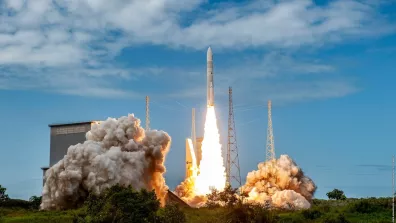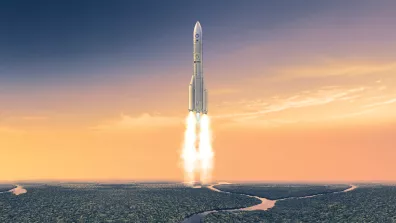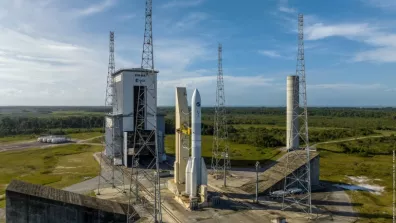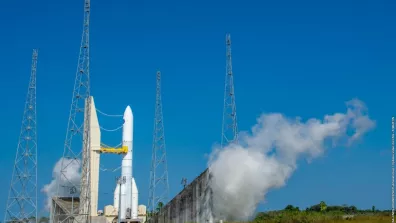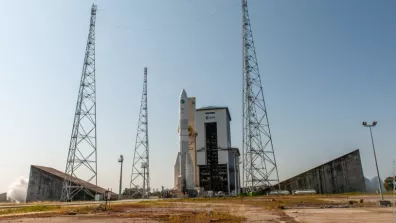The first Ariane 6 rocket was successfully launched on 9 July 2024, completing its mission of releasing several varied satellites into a circular Earth orbit and restoring Europe’s independent access to space. The inaugural flight, designated VA262, was a great success for Europe, paving the way for the next Ariane 6 flight in 2024 and demonstrating the new heavy-lift rocket’s ability to reach its target orbit and deploy satellites and constellations.
Since launch, data from the launch site and data beamed back by the rocket and its payloads have been poured over by teams at ESA, ArianeGroup, CNES and Arianespace, beginning the analysis that will help teams understand every moment of the historic launch and ensure the performance of future flights. With the launch of Ariane 6, Europe is back in space with its own launch capability.
Liftoff – a seamless ride from Earth to orbit
Ariane 6 lifted off from Europe's Spaceport in French Guiana at 16:00 local time (20:00 time BST, 21:00 time CEST). Despite being the very first flight of the rocket, it launched on the targeted day on time and without a problem in the launch ‘chronology’ – the detailed sequence of steps in the hours and minutes counting down to launch.
The long-awaited launch choreography finally took place, much anticipated by the entire Ariane 6 development team: the Vulcain 2.1 engine roared to life and in sync the arms delivering cryogenic propellant sprang open, the launchpad’s water injection system was activated and the boosters ignited.
With this, the rocket seamlessly soared to space, its boosters separating 137 seconds after liftoff and the main stage separating approximately five minutes later. The upper stage engine then fired for the first time to get Ariane 6 into an elliptical orbit 300 by 600 km above Earth, achieving the first great result: the in-flight ‘chill-down’ and first ignitions of the Vinci engine and of the Auxiliary Propulsion Unit (APU).
Upper stage successfully reignites and satellites deploy
After a ‘coasting’ phase lasting 35 minutes – i.e. a period without thrust from the main Vinci engine – the engine fired up again for the second time. With this Ariane 6’s newest feature, its reignitable upper stage, proved its ability to re-shape the rocket’s orbit, maximising the increase in its velocity.
This second Vinci boost circularised Ariane 6’s orbit at 580 km, ready to release its eight satellite missions into space around Earth. Robusta-3A, Replicator, Curium One, GRBBeta, CURIE, ISTSat-1, 3Cat-4 and OOV-Cube were all successfully deployed into orbit.
The commands were also sent to activate the five onboard experiments, many of which have already sent impressive data home. YPSat, the onboard experiment from ESA’s Young Professionals network, produced spectacular images and videos from fairing separation to satellite deployment.
Technology demonstration provides data mine, with APU behaviour under investigation
The final phase of Ariane 6’s inaugural launch was a technical demonstration, testing for the first time the behaviour of the upper stage under microgravity which could not be tested on ground.
The APU ignited for the second time, the functioning was then aborted for reasons still under investigation. This meant the Vinci engine's third boost could not take place. This final boost would have put the upper stage into a reentry orbit to safely burn up through Earth's atmosphere.
Given this fact, the upper stage then behaved nominally: the Vinci engine was not restarted and the onboard software triggered the ‘passivation’ of the upper stage, by removing any energy on board to prevent possible explosions.
Consequently, and in line with expectations, the launcher system did not release the two reentry capsules onboard to prevent the creation of additional space debris. By successfully executing this complex sequence, Ariane 6 demonstrated optimal “back-up mode” function.
Confidence in Ariane 6 and looking forward to next flight
The behaviour of Ariane 6 during its inaugural flight has given teams great confidence in the validity and predictions of the Ariane 6 user manual, in terms of the dynamical environment created for onboard payloads. All satellite separations were precisely executed and last but not least, the launch pad was found in fine condition after take-off, resisting to the very high level of thermal and mechanical loads associated with the solid booster operation.
The consolidated analysis of all flight data will allow for the fine tuning and improvement of all Ariane 6 launch sequences and flight operations. On this basis, teams have begun preparations for its second flight, scheduled for the end of the year with Arianespace as its operator and launch service provider.
Next milestones
Analysis of the APU’s behaviour is ongoing and further information will be made available as soon as possible, while the next task force update is expected in September.


